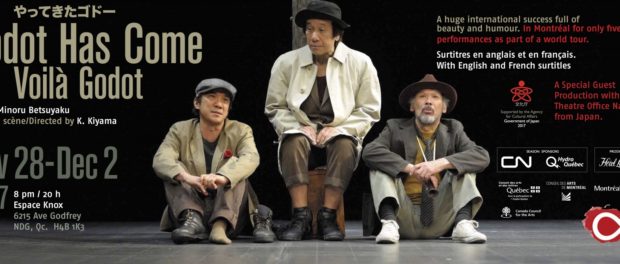Godot Has Come, but Gets Lost in Translation
When we last left off in Samuel Beckett’s play, Waiting for Godot, Vladimir and Estragon were waiting for the late-to-the-party Godot to arrive. Their long wait is interrupted only by the slapstick-ish duo of Pozzo and Lucky, and a boy. In this Japanese sequel, Godot Has Come by Minoru Betsuyaku and directed by K. Kiyama, the wait is over. Vladimir and Estragon not only get to meet Godot, but so do a number of other people, two “receptionists”, an old woman, Pozzo, Lucky, and a boy.
In the hands of even the greatest actors, Becket’s existential classic Waiting for Godot falls somewhere between a snoozefest and an engrossing intellectual garden party. As a minimalist work, it becomes all things to all people who mine its words and situations for deeper meanings. But, briefly, it is about two guys waiting. This familiar, boring, and stressful situation is rendered bearable to the audience through the witty, word twisting dialogue, the absurdist interruptions, and the tangental observations that our two protagonists have, all supplied from the pen of Beckett and the talent of its actors.
Godot Has Come is part II. Vladimir (Mitsushi Matsumoto) and Estragon (Genjiro Mori) are being sought by others — one as a parent to a child, the other as a child to a parent. Anime style, two receptionists carry their desk whenever they are required to set up a place to receive others. Godot’s (Yuga Yoshino) arrival is met with indifference and he practices for his next encounter with his umbrella.
From what I can tell, Godot Has Come is true to the original. Absurd. Existential. Word heavy. The dialogue of the play is the focus over its action, and it involves waiting. Only now, the show is on a world tour which only serves to ramp up the absurdity. Everything is in Japanese. Subtitles flash overhead on a screen, but the minute one looks at the screen, one loses the action happening. Intentionally or not, the subtitles don’t always match with the actors’ speech, making it confusing to tell whose words are whose.
It’s a hard play to assess. Visually it’s very appealing. Everything is presented with a precision I associate with Japanese art — the lighting, the bus-stop/lamp post set, the costumes, the blocking — all are carefully considered. The acting, ignoring the fact that I have almost no idea what anyone is saying, comes through in the gestures, expressions, and intonations of a very tight cast. However, most of what makes this play worth seeing is lost by an inability to convey the dialogue effectively. I so badly longed to know what the characters were saying, but each time I looked at the subtitle screen, I couldn’t watch the show and its action. Each time I watched the actors and the action, I had no idea what was being said. It was frustrating and dizzying. To make matters worse, when I watched the subtitle screen, no names are given to indicate who is speaking and at times, there was a mismatch between the subtitle’s appearance and the speaker.
Nonetheless, with a few tweaks to the presentation, this show might be excellent. It’s hard to say. An audience can’t look at two places at once. An absurd play became even more absurd, and I suspect that was not the point.
Godot Has Come is on a world tour. It was at the beautiful Espace Knox on November 29-December 2.
1 Comment on Godot Has Come, but Gets Lost in Translation
Comments are closed.







Hey, perfect assessment of the play.